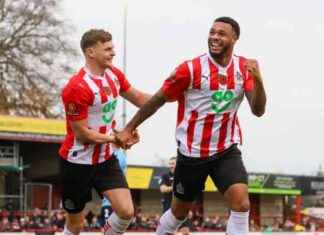Gone are the days when rap seemed reserved for the youth of low-income housing estates. More provincial, more bourgeois too, the genre has changed. To the point that many political sensitivities are expressed there today. Panorama.
In his piece “Don’t Laïk”, Médine virulently attacks the “laïcards”, guilty in his eyes of defending a “perverted” vision of secularism. “We are the scarecrow [sic] of the Republic / The elites are the proselytes of the ultra-secular propagandists / I am enough of Allah, no need to be secularized. Freeze Corleone is an admirer of the pan-Africanist Kémi Séba. In the name of the competition of memories, he dares to assure, in a piece entitled “Congo”: “S/O [shout out] Congo / Tous les jours, R à F [rien à foutre] de la Shoah. »
The Toulouse brothers Bigflo and Oli, with words as sensitive as they are consensual, could take their card from the UDI. A concern for nuance that distinguishes them from vociferous colleagues. Sometimes for the best, as in “Le Cordon”, a delicate account of the horrors of abortion. Sometimes for a questionable result. In “Sacré Bordel”, the artists of Algerian and Argentinian origin question their French identity: “In the grimoire, there are the Gauls, there are the knights / But in the kitchen, there is my grand- mother and her Berber tattoos erased. “A real balancing act, which earned them, on social networks, the label of macronist rappers…
The Lyonnais Millésime K presents himself as “patriotic”. Her favorite theme, declined throughout songs entitled “Marianne”, “Douce France” or even “Jeanne d’Arc”: the denunciation of insecurity and the assistantship (“We censor the patriots and we encourage delinquency “). A very Bardella-compatible music… More confidential, the “nationalist” Kroc Blanc presents himself as “the only French rapper”. He rails, in “Anti-France”, at those “rascals despising their luck to be born so far from their farted backwaters”.
The Toulouse rapper D1ST1 has made a name for himself with his songs to the glory of the Yellow Vests. He denounces the police blunders, insists on the fraternity of the demonstrators: “There is mutual aid and sharing, I invite you to come down / You will understand that it is the police that we must defend ourselves. As for Orelsan, who comes from the “middle class, middle class”, he fondly describes the industrial areas that surround Caen, where he grew up. His track “Manifeste” recounts a Parisian protest gone wrong. Without forgetting the Marseillais Jul, rapper in tap-socks: the idol of the Old Port has supported the Yellow Vests.
Based in Miami, the “new rich” Booba has an uninhibited relationship with money. “My Lamborghini took a few speed bumps,” he hums in one of his hits, “92i Veyron.” Same capitalist frenzy with his younger brother Ninho, who multiplies the references to material success: “I arrive in Dior, I arrive in Dior, and it’s Machiavellian plans that we develop / I recount the bodies, I go back in bus, my wife’s neck is filled with gold” (“25 G”). One of his tracks is called “Fendi”, in reference to the Italian luxury brand: “Fuck the bus, I opted for an Audi, rue Rivoli. »
Gims was signaled by an unexpected exit on the pyramids, which he assures that they were in fact… power stations. In ancient Egypt, “people had electricity, and historians know it”, guaranteed, against all evidence, the former figurehead of Sexion d’Assaut, a flagship group of the 2010 decade. the anti-globalization rapper Kenny Arkana, she wonders in the preamble of her song “Masked violence” (2021): “Epidemics, maybe so that we are afraid to gather / Or just to business (sic) a bunch of poisoned vaccines. »
The very Parisian Nekfeu likes to display his literary references, from Zola to Éluard via Kundera. “I’m the first ex-poor to take you to see exhibitions,” he tells a mysterious young woman in his track “Princess.” His pieces abound in disputes with a conquest rue de Rivoli, in heartache on the banks of the Seine. Another favorite rapper of France Inter: Lomepal, son of a painter and a proofreader at Gallimard, and desperate storyteller of the mirages of the Parisian night. In his piece “Paris”, the artist evokes with nostalgia his “bobuns and his nocturnal swims at the Butte-aux-Cailles”.







